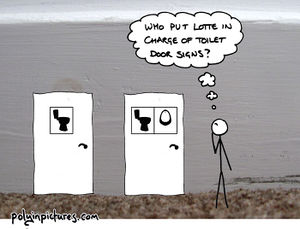Public toilets
| |
This article is a stub. You can help the Nonbinary wiki by expanding it! Note to editors: remember to always support the information you proved with external references! |
Public toilets are a serious challenge for gender nonconforming and nonbinary people. Places that only offer men's or women's restrooms create an unsafe situation where gender nonconforming people have to choose between potentially getting harassed or assaulted, or having to wait so long that they get health problems. A single-occupancy, gender-neutral restroom is safest, so it is important for everyone's rights to be able to find these spaces, and to ask for them to be created in public places that need to have them.
Problems
Restrooms for able-bodied people are often assigned to male and female, with little to no provision for people who don't fit the gender binary. For nonbinary and gender nonconforming people, having to choose whether to go in a men's room or women's room can be a source of social anxiety and gender dysphoria. People who are seen as gender nonconforming may be subjected to harassment, violence, or arrest if others think they have entered the wrong restroom. Because of these risks, some people try to avoid using public toilets by waiting so long that it is bad for their health. Health risks from waiting too long to use a restroom include urinary stones, dehydration, cystitis, and infections of the bladder and kidneys.[1]
- Go Where? is an article on the gendering of public toilets, looking into the visual symbols and what they say about language and public perception of gender.
- "Renaming the bathrooms: A cruel trick for queer ends," by androgyne Raphael Carter regarding a practical joke about signs on restroom doors, providing some levity about these issues.
Finding gender-neutral restrooms
How to find gender-neutral public toilets anywhere, and how to handle situations where these aren't available.
- Refuge Restrooms is a replacement for Safe2pee. It also has an iOS app available.
- Safe2pee is a crowdsourced world map of public toilets that are genderfree and/or accessible. There is an iPhone app that uses the information so that you can find places when you're out and about, called Transquat.
Advocating for gender-neutral restrooms
There has long been a common misconception that having separate restrooms for men and women helps prevent assault. However, facts don't support this assumption. For preventing assault, a single-occupancy restroom is more effective. There is no reason for a single-occupancy restroom to be only for a certain gender. A gender-neutral, single-occupancy restroom makes public places safer for everyone.[1]
People who have babies or small children with them also want gender-neutral, single-occupancy restrooms. People with disabilities want accessible, single-occupancy restrooms, too. Transgender and gender nonconforming people can unite with these groups to organize and advocate for these improved public restrooms more effectively.[2]
These are some resources for people who want there to be gender-neutral restrooms in public places.
- Transgender Law Center. (2005). Peeing in peace: A resource guide for transgender activists and allies. http://transgenderlawcenter.org/issues/public-accomodations/peeing-in-peace
- Sylvia Rivera Law Project (Producer) & Mateik, T. (Director). (2003). Toilet training: Law and order in the bathroom (DVD). United States: Silvia Rivera Law Project.
